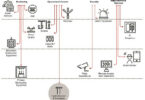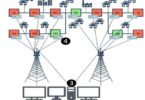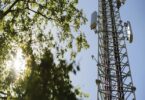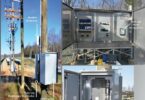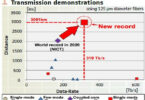by Laurent Guise and Tom Berry, Schneider-Electric, France, and Frances Cleveland, Xanthus Consulting International, USA
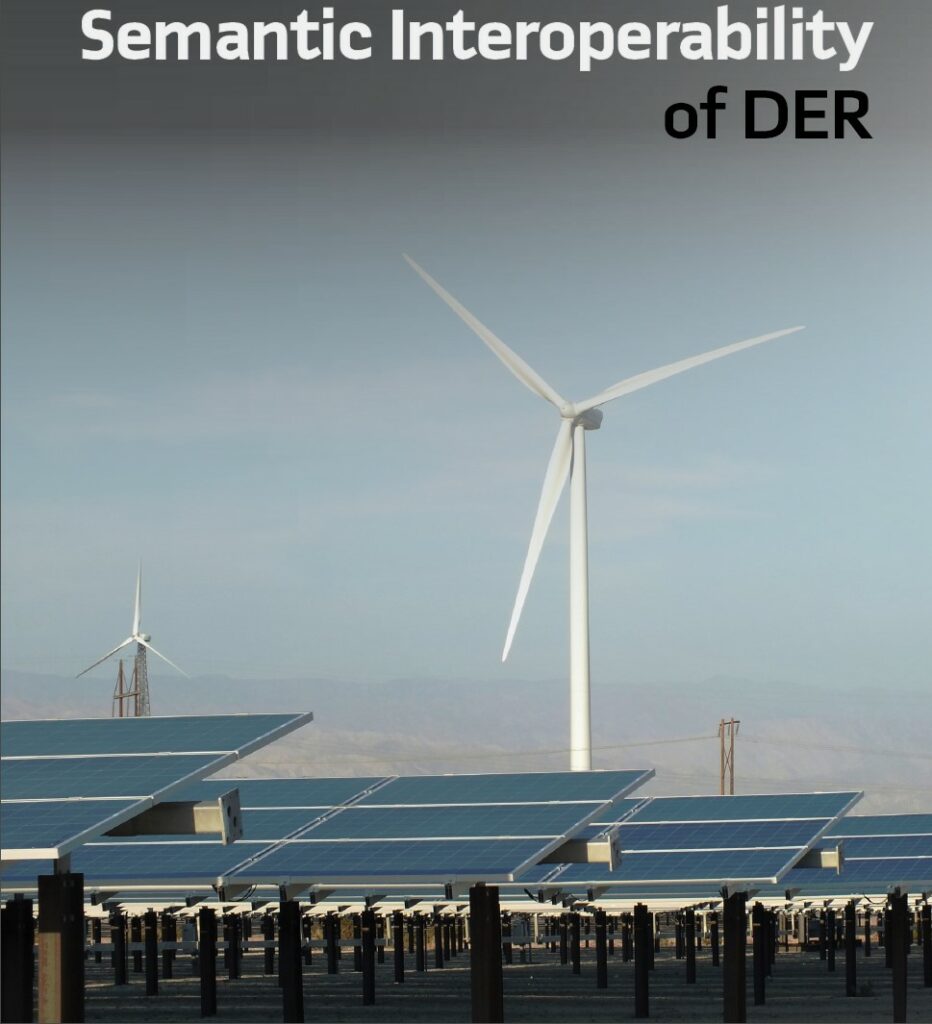
Interoperability requirements in the world of DER: Across the world, people are racing to install more and more renewable energy resources. Most of these resources are connected to the distribution networks, hence the term Distributed Energy Resource (DER). Their increasing number leads to an increasing need of observability and controllability of DERs by stakeholders in charge of managing their contribution to the grid, and finally to increasing interoperability issues.
As the numbers of connected DERs increases, they have more and more influence on the network voltage and frequency. At the same time, the introduction of power electronics and cost-effective battery storage provides the opportunity to build smart inverters and microgrids that can provide autonomous control in both normal and emergency conditions.
Due to the increasing number of DERs, it is common for utilities to interact with DERs, possibly through aggregators or virtual power plants. This creates the need for distributed control systems that exchange information between the utilities, the DER (DERMS), all the way down to individual DER controllers. This needs communication protocols to transfer the information both ways. To achieve inter-operability, it is fundamental that all the parties have a shared understanding of the information semantics, or in other words a data model. This is exactly the approach of IEC 61850 which defines data models in association with a series of mappings to specific protocol encoding (“bytes-on-the-wire”).
The IEC 61850-7-420 Edition 2 tackles this problem of data models of inter-operability, starting with the details of the DERs so that operators can monitor and operate their installations, and extends it to handle autonomous control functions and provides a way of describing for DER information can be aggregated for DERMS and utilities.
Applying the IEC 61850 data model while not using a 61850 protocol: The IEC 61850 data model can obviously be used with the IEC 61850-8-1/8-2 protocols, but can also be mapped in a standard way to most of the other protocols used in the DER market, such as IEC 60870-5-101/104 (IEC 61850-80-1), the MESA-DER de facto standard (combining IEC 61850 semantic model with IEEE 1815 (DNP3) and the IEEE 1815.1 mapping of CDCs), OPC-UA (IEC 61850 object mapping companion specification), and Modbus (IEC 61850-80-5 – under development). Even if the IEC 61850 data models are not directly mapped, they can be (and are being) used as the source for other data models, such as for IEEE 2030.5 and SunSpec Modbus.
This means that any devices using one of these protocols can express its interface using the semantically defined data objects of IEC 61850. And the benefits of proceeding that way are truly amazing, as described below.
Benefitting from the IEC 61850 ecosystem by using the IEC 61850 data model even if using Modbus, DNP3, IEC 60870-5-101/104, OPC-UA … As soon as interfaces of Modbus, DNP3, 101-104, OPC-UA devices are expressed by using the IEC 61850 data model, their integration can be greatly simplified, and interoperability can be reached with higher quality and efficiency. The main concrete benefits one can expect include a standardized and formal expression of device capabilities, i.e.:
- Nameplate and operational status
- Functions supported by the device
- Monitoring and control objects exposed through the Modbus/ DNP3/101-104/OPC-UA interface
This standardized approach can be formalized through the use of SCL which could enable a manufacturer/integrator to expose all these through a machine processable way, thanks to the XML-based language as defined by SCL. This approach could be extended respectively by:
- IEEE 1815.1 and MESA-DER de facto standard for mapping DNP3 data with 61850
- IEC 61850-80-1 for mapping IEC 60870-5-101/104 data with 61850
- IEC 61850-80-5 for mapping Modbus data with 61850 (to come soon)
- OPC-UA Modbus companion standard for mapping OPC-UA power data with 61850
The DNP3, Modbus, and IEC 101/104 protocols have no semantic data models of their own and include only basic standardized formats for analog or status values, but not for specific data objects. Therefore, different implementations could result in very different formats for the same data objects, for instance, with very different unit multipliers, possibly different units, very different number of bytes, and certainly different enumerations and control states (for example on-off could be true-false or false-true). This requires humans to understand and manually program the transformations between different systems, including SCADA systems, DERMS, and DER facilities and devices.
IEC 61850 semantic definitions of data objects simplify all this. Each IEC 61850 data object has a well-defined format and attribute structure in their Common Data Classes (CDCs), which guarantees their semantic interoperability. These CDCs can then be mapped to the individual protocol formats.
The beauty is that the transformation from the CDCs to the basic protocol formats can be expressed in a machine processable way, and so does not require any changes to the device interface, since this transformation could be exposed in a separated file. In most cases, these transformations could rely primarily on pre-established “standardized transformation rules,” with “proprietary transformation rules” only needed for exceptions.
This approach provides significant benefits:
- No need anymore (or very much reduced) of system integrator human assessment of device data sheets and their programming of such transformations
- Large reduction of cost and time, as well as a dramatic increase of quality and system agility for integrating new devices
A concrete example of integration of DERs to a SCADA, using Modbus, DNP3, IEC 60870-5-101/104, OPC-UA …
Let’s imagine a utility SCADA or an aggregator’s DERMS which needs to connect to tens or hundreds of DERs from various manufacturers:
- Without a standardized semantic data model, each integration of a new DER required the DER integrator to program different modules to convert the semantics of this new DER with the one used by the SCADA or DERMS. Now multiply these times the number of SCADA and DERMS systems that the DER integrators would need to interface their DERs with
- With the standardized IEC 61850 semantic data model, each SCADA and DERMS and DER would each have only one generic interface for Modbus, one for DNP3, one for 101/104, and/or one for OPC-UA. Each of these interfaces would be able to import a machine processable SCL file describing the specific DER capabilities. Thus, all data will be automatically converted without needing ANY CHANGES to these interfaces.
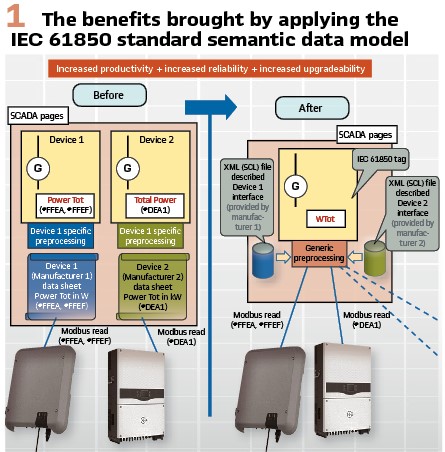
These benefits are depicted in the “before/after” diagram shown in Figure 1.
A win-win situation for all DER market players … Thus, even when the IEC 61850 protocols are not used, applying the IEC 61850 standard semantic data model greatly benefits to all DER stakeholders:
- The DER manufacturer: no need of modifying the DER communicating device, much easier integration into any systems by providing a predefined SCL file specifying its DER device interface, and reduced need of support
- The system integrators: huge gain of efficiency and quality for integrating devices
- The SCADA and DERMS provider: much extended market coverage by providing generic device interfaces able to import SCL capabilities devices for the appropriate protocols
- The end-users by having more reliable implementations, faster deployments, and much higher agility and flexibility for supporting new DER integrations
The IEC 618507-420 Data Modelling Principles Applying to DER
The DER definition in the context of IEC 61850-7-420 and its recursive approach: Traditionally a DER is considered as an energy resource comprised of generation and/or storage connected at the low or medium voltage distribution level.
However, from an energy management perspective, similar services can be obtained by managing loads in reverse ways of generators (decreasing a load would have similar effects than increasing generation from a balancing perspective). For that reason, the IEC 61850-7-420 extended the DER definition to include controllable loads.
The other main extension of the DER definition that the IEC 61850-7-420 made was to encompass aggregations of DER units as part of DER definition.
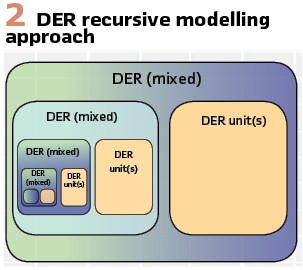
This was possibly implicit in usually accepted definition, but 61850-7-420 made it explicit by recognizing that a DER may be composed of multiple elements of possibly different nature (generation, load, storage), up to a point where DER may even become virtual in that respect, comprising an aggregated set of DERs possibly not connected to the same electrical points.
Based on the assessment above, it appears clear that a DER also contains or aggregates DERs (of whatever types, including mixed types), and this makes the model recursive as presented in Figure 2.
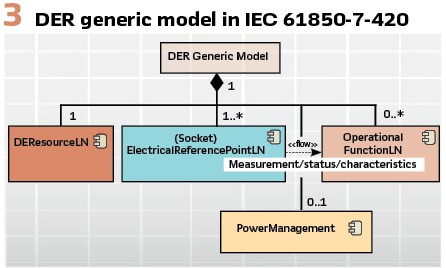
The generic DER model: A new approach has been conducted in IEC 61850-7-420 aiming at finding a common model structure for all types of DERs as defined here. This generic model, as depicted in Figure 3, is composed of:
An element related to the resource itself (brown in the figure), hosting typically its nameplate information, its ratings, its settings, its status. It is a child of the DEResourceLN abstract class.
An element (or possible multiple) related to the electrical point of connection of the considered resource (the socket on the area EPS) (blue in the figure). This is a child of the ElectricalReferencePointLN abstract class.
An element related to the power management “decision maker,” i.e. a black box determining the best expected power behavior of the resources (yellow in the figure). This is the DPMC power management LN.
A set of operational functions reflecting the requirements for specific power behavior of the resource. These can reflect typically the network code functions applying to the DER, but also market-related requirements. This is a child of the OperationalFunctionLN abstract class.
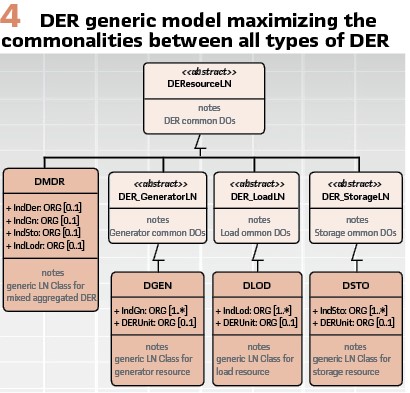
Next, the modelling structure tries to maximize the commonalities between all types of DER (generation, load, or storage), while favoring a generic model agnostic from the DER technology. This has led to the model structure depicted in Figure 4.
IEC 61850-7-420 application to specific DER Unit technology: The IEC 61850-7-420 also includes specific data models for different types of DERs, such as PV systems, fuel cells, diesel generators, battery storage systems, and combined heat and power systems. The properties for each technology are defined in resource specific LNs, while still linked to its generic LN parent (DGEN, DLOD or DSTO). The resulting model structure together with a typical implementation in the case of PV generator is shown in Figure 5).
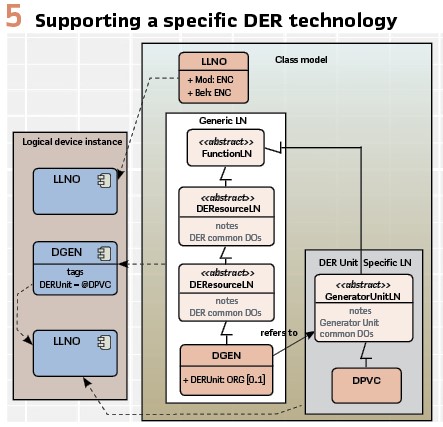
IEC 61850-7-420 Application to Aggregated DERs: Since aggregations of DER may be dynamic, both from a configuration perspective and from an operations perspective, the IEC 61850-7-420 model includes a methodology for linking DERs into aggregations. For instance, DERs may be aggregated as virtual power plants (VPPs) to provide certain types of ancillary services or may at times be aggregated by their specific abilities to support price-based functions or may be treated as grid-connected microgrids.
In the model, these dynamic aggregations are supported by the use of special links: InclGn, InclSto, InclLod, InclDer for the inclusion of a DER of respectively a generator (or set of generators), a load (or set of), a storage DER (or a set of), or a mixed DER (a set of DER of mixed natures).
The Concept of DER Equivalency: For different reasons, a storage DER may have to be used either as a generator or as a load. Or a DER may have to expose its content through a specific characteristic (e.g. renewable, dispatchable, under contract for providing specific ancillary services, supporting a critical load, etc.).
For that purpose, the concept of equivalent DER resources is included, supporting the possibility of expressing capabilities and behaviors of a given resource in different manners.
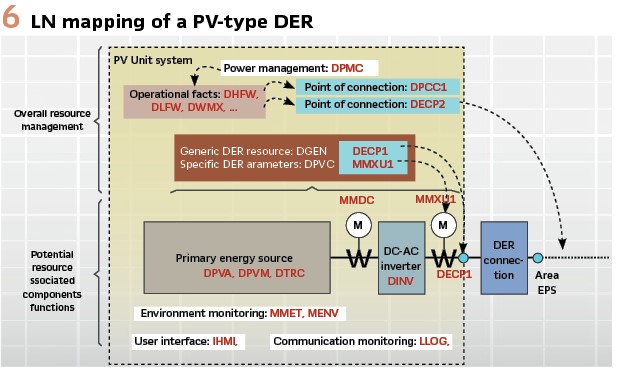
Mapping these concepts on concrete DER cases: Figure 6 shows an example of the IEC 61850-7-420 LNs that could be used for a PV DER, including:
- The generic LN as a generator unit (DGEN)
- The additional parameters specific to PV (DPVC)
- The electrical connection (local of point of connection DECP2 or of the plan to the area power system DPCC)
- Some components (the inverter DINV, the PV array (DPVA), the PV tracker (DTRC)
- Some electrical measurements (MMDC, MMXU)
- The key environment sensing functions (MMET, MENV)
- The power management related LN DPMC
- A set of operational functions “constraining” the behavior of this DER in that case frequency-watt functions, (DHFW, DLFW), maximum active power output (DWMX), etc.
The DERs technologies included in IEC 618507-420: The following DER technologies are currently included in IEC 61850-7-420:
- Photovoltaic DERs
- Battery storage DERs
- Diesel generators (reciprocating engines) DERs
- Fuel cells DERs
The extension of these concepts to microgrids: From a modelling perspective, the “distance” between a DER as defined above and a pure microgrid is not huge. Considering that the modelling concepts already support the aggregation of DER, the main missing modelling parts are the functions related to the connection and disconnection of a microgrid, and its ability to run when disconnected (frequency and voltage management). This additional work has already been engaged within IEC TC57 WG17, as IEC TR 61850-90-23.
The extension of these concepts to other types of energy resource technologies: All around the planet, the optimal usage and conversion of all types of energy is becoming critical, including thermal, natural gas, hydro, heat pumps, and even special energy-providing technologies, such as compressed air, concentrated solar, tidal, ocean waves, etc. In addition, electric vehicles may also be considered as special cases of energy storage and can be treated as DER. These technologies will need to be reflected in data models, as well as conversion processes of energies from one type to another. The concepts presented above are being extended to support some of these. A first TR for thermal energy will be ready soon: IEC TR 61850-90-27 and work is progressing on electric vehicles as DER.
Operational Functions Modelling
An important and comprehensive work has been achieved in this new edition of IEC 61850-7-420 in order to support a large set of operational functions applying to DERs, and especially the requirements expressed in the grid codes, specified in IEC 62786 (international approach), IEEE 1547 (North America) and EN 50549 (Europe).
Through an in-depth assessment a set of more 18 functions have been modelled in detail with the goal to fulfil compliance with these requirements. This covers typically:
Ride-through functions:
- LN DHVT: High voltage ride through operational function
- LN DLVT: Low frequency ride through operational function
- LN DHFT: High frequency ride through operational function
- LN DLFT: Low frequency ride through operational function
Frequency-active power operational functions:
- LN DHFW: High frequency-active power operational function
- LN DLFW: Low frequency-active power operational function
Active power operational functions:
- LN DVWC: Voltage-active power (Volt-Watt) operational function
- LN DWGC: Set active power for generating or consuming operational function
- LN DWFL: Active power following operational function
- LN DAGC: Automatic generation control operational function
- LN DTCD: Coordinated Charge/Discharge operational function
- LN DWMX: Limit maximum active power operational function
- LN DWMN: Limit minimum active power operational function
Power factor operational functions:
- LN DFPF: Set fixed power factor operational function
Reactive power operational functions:
- LN DVVR: Voltage-reactive power (Volt-VAr) operational function
- LN DVAR: Constant reactive power operational function
- LN DWVR: Active power – reactive power (Watt-VAr) operational function
- LN DRGS: Dynamic reactive current support operational function
A previous article in PacWorld magazine (2020-06) already provided some insights on part of those operational functions. A more global presentation of all of them would be worth a full article.
Future Publication of Profiles for the IEEE 1547 Grid Code Functions
There is general agreement that data semantic modelling is a “must,” and an essential step towards reaching the goal of interoperability. The tremendous flexibility provided by the IEC 61850-7-420 data model can be overwhelming, so specific “profiles” of the data objects will be needed for specific contexts.
In particular, new work is starting to profile the operational functions required to meet the IEEE 1547 grid code requirements. This work will take the best from the “Basic application profile” concepts developed in IEC 61850-7-6, enhanced by the coming IEC 61850-6-100 function modelling.
The aim is to deliver a fully machine processable profile.
Conclusion
The new edition of the IEC 61850-7-420 semantic data model is taking a huge step forward to support the interoperability of DER and their integration in complex systems. The data models can be used almost independently of the actual communication protocols. IEC 61850 provides a rich set of communication services, but it is equally possible to map the data objects to well established communication protocols such as IEEE 1815 (DNP3), Modbus, IEC 60870-5-101/104 or OPC-UA.
There are also many opportunities to extend these ideas more widely for the power systems of the future. This work is just the starting point for additional extensions, such as full microgrids application, multi-energy systems (thermal and gas), coordination of different DER to provide the desired results.
Biographies:

Laurent Guise graduated from the Ecole Supérieure d’Electricité (ESE SUPELEC Engineering school) and worked for Schneider Electric for more than 20 years. Within Schneider-Electric, he has been awarded the distinction of a Master Expert in Smart Grids and IEC 61850. He is leading, at the corporate level, the definition, coordination, and implementation of the smart grid standardization policy. He had been for 6 years the convenor of IEC TC57 WG17 in charge of extending the IEC 61850 series for DER. He chairs the CEN-CENELEC-ETSI Smart Grid Coordination Group in charge of ensuring the availability of the smart grid deployment set of standards in Europe.

Tom Berry studied Electrical Engineering at Bath University, UK. For the last 25 years he has worked for Schneider Electric in the UK and in France. He has worked on control centre projects integrating SCADA systems within dispatch training simulators, transmission and distribution network management systems. He now works “closer to the edge” as a software architect for feeder automation RTUs. He is a member of several IEC TC57 WGs and the editor of IEC TS 62361-102 technical report on CIM-61850 harmonization.

Frances Cleveland has a B. Sc. degree in Applied Physics and Electrical Engineering from Harvard University, a M. Sc. degree in Electrical Engineering and Computer Science from the University of California at Berkeley, and MBA from San Jose State University. She is President of Xanthus Consulting International and has consulted on Smart Grid information and control system projects in the electric power industry for over 36 years.
She is currently consulting to NIST as a Technical Champion for the Smart Grid Interoperability Panel (SGIP) on DER and cybersecurity, and to EPRI on the National Electric Sector Cybersecurity Organization Research (NESCOR). In the IEC, she is convenor of IEC TC57 WG15 for IEC 62351 cybersecurity standards for power system operations and is the editor for IEC TC57 WG17 for IEC 61850-7-420 information standards for DER, EV, and DA. In the IEEE, she is past chair of the IEEE PES PSCC.



